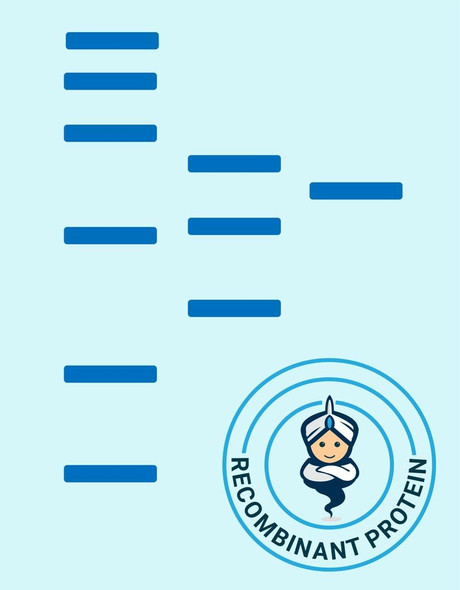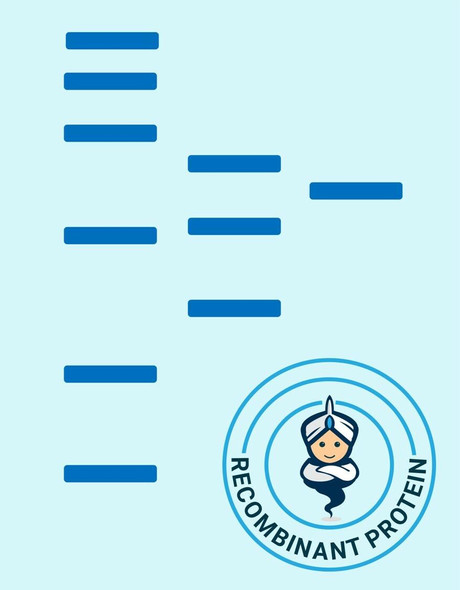Description
| Product Name: | Human PLA2G5 Recombinant Protein |
| Product Code: | RPPB2124 |
| Size: | 10µg |
| Species: | Human |
| Target: | PLA2G5 |
| Synonyms: | Calcium-dependent phospholipase A2, EC 3.1.1.4, Phosphatidylcholine 2-acylhydrolase, PLA2-10, Group V phospholipase A2, GV-PLA2, MGC46205, hVPLA(2), DKFZp686C2294, sPLA2-V, PLA2G5. |
| Source: | Escherichia Coli |
| Physical Appearance: | Lyophilized (freeze-dried) powder. |
| Formulation: | Filtered (0.4um) and lyophilized in 0.5 mg/mL in 0.05M Acetate buffer pH4. |
| Solubility: | Add 0.1M Acetate buffer pH4 to prepare a working stock solution of approximately 0.5 mg/mL and let the lyophilized pellet dissolve completely. For conversion into higher pH value, we recommend intensive dilution by relevant buffer to a concentration of 10�g/ml. In higher concentrations the solubility of this antigen is limited. Product is not sterile! Please filter the product by an appropriate sterile filter before using it in the cell culture. |
| Stability: | Store lyophilized protein at -20°C. Aliquot the product after reconstitution to avoid repeated freezing/thawing cycles. Reconstituted protein can be stored at 4°C for a limited period of time; it does not show any change after two weeks at 4°C. |
| Purity: | Greater than 95% as determined by SDS PAGE. |
| Amino Acid Sequence: | MRGSHHHHHH GMASHMGLLD LKSMIEKVTG KNALTNYGFY GCYCGWGGRG TPKDGTDWCC WAHDHCYGRLEEKGCNIRTQ SYKYRFAWGV VTCEPGPFCH VNLCACDRKL VYCLKRNLRS YNPQYQYFPN ILCS |
Phospholipase A2 (PLA2) catalyzes the hydrolysis of the sn-2 position of membrane glycerophospholipids to liberate arachidonic acid (AA), a precursor of eicosanoids including prostaglandins and leukotrienes. The same reaction also produces lysophosholipids, which represent another class of lipid mediators.The secretory PLA2 (sPLA2) family, in which 10 isozymes have been identified, consists of low molecular weight, Ca2+-requiring secretory enzymes that have been implicated in a number of biological processes, such as modification of eicosanoid generation, inflammation, and host defense.This enzyme has been proposed to hydrolyze phosphatidylcholine (PC) in lipoproteins to liberate lyso-PC and free fatty acids in the arterial wall, thereby facilitating the accumulation of bioactive lipids and modified lipoproteins in atherosclerotic foci.In mice, sPLA2 expression significantly influences HDL particle size and composition and demonstrate that an induction of sPLA2 is required for the decrease in plasma HDL cholesterol in response to inflammatory stimuli. Instillation of bacteria into the bronchi was associated with surfactant degradation and a decrease in large:small ratio of surfactant aggregates in rats.
Secreted Phospholipase A2-V Human Recombinant was produced with N-terminal His-Tag. PLA2G5 His-Tagged Fusion protein is 15.5 kDa containing 118 amino acid residues of the human secreted phospholipase A2-V and 16 additional amino acid residues � His-Tag (underlined).
| UniProt Protein Function: | PLA2G5: PA2 catalyzes the calcium-dependent hydrolysis of the 2- acyl groups in 3-sn-phosphoglycerides. This isozyme hydrolyzes more efficiently L-alpha-1-palmitoyl-2-oleoyl phosphatidylcholine than L-alpha-1-palmitoyl-2-arachidonyl phosphatidylcholine, L- alpha-1-palmitoyl-2-arachidonyl phosphatidylethanolamine, or L- alpha-1-stearoyl-2-arachidonyl phosphatidylinositol. May be involved in the production of lung surfactant, the remodeling or regulation of cardiac muscle. Defects in PLA2G5 are the cause of fleck retina, familial benign (FRFB). An autosomal recessive condition associated with a distinctive retinal appearance and no apparent visual or electrophysiologic deficits. Affected individuals are asymptomatic, but fundus examination reveals a striking pattern of diffuse, yellow-white, fleck-like lesions extending to the far periphery of the retina but sparing the foveal region. Belongs to the phospholipase A2 family. |
| UniProt Protein Details: | Protein type:Secreted; Lipid Metabolism - alpha-linolenic acid; Lipid Metabolism - glycerophospholipid; Secreted, signal peptide; Lipid Metabolism - linoleic acid; Cell surface; Phospholipase; Lipid Metabolism - ether lipid; EC 3.1.1.4; Lipid Metabolism - arachidonic acid Chromosomal Location of Human Ortholog: 1p36-p34 Cellular Component: extracellular region Molecular Function:phospholipase A2 activity Biological Process: phosphatidic acid biosynthetic process; phospholipid metabolic process Disease: Fleck Retina, Familial Benign |
| NCBI Summary: | This gene is a member of the secretory phospholipase A2 family. It is located in a tightly-linked cluster of secretory phospholipase A2 genes on chromosome 1. The encoded enzyme catalyzes the hydrolysis of membrane phospholipids to generate lysophospholipids and free fatty acids including arachidonic acid. It preferentially hydrolyzes linoleoyl-containing phosphatidylcholine substrates. Secretion of this enzyme is thought to induce inflammatory responses in neighboring cells. Alternatively spliced transcript variants have been found, but their full-length nature has not been determined. [provided by RefSeq, Jul 2008] |
| UniProt Code: | P39877 |
| NCBI GenInfo Identifier: | 730258 |
| NCBI Gene ID: | 5322 |
| NCBI Accession: | P39877.1 |
| UniProt Secondary Accession: | P39877,Q8N435, |
| UniProt Related Accession: | P39877 |
| Molecular Weight: | |
| NCBI Full Name: | Calcium-dependent phospholipase A2 |
| NCBI Synonym Full Names: | phospholipase A2 group V |
| NCBI Official Symbol: | PLA2G5�� |
| NCBI Official Synonym Symbols: | FRFB; GV-PLA2; PLA2-10; hVPLA(2)�� |
| NCBI Protein Information: | calcium-dependent phospholipase A2 |
| UniProt Protein Name: | Calcium-dependent phospholipase A2 |
| UniProt Synonym Protein Names: | Group V phospholipase A2; PLA2-10; Phosphatidylcholine 2-acylhydrolase 5 |
| Protein Family: | Calcium-dependent phospholipase |
| UniProt Gene Name: | PLA2G5�� |
| UniProt Entry Name: | PA2G5_HUMAN |








